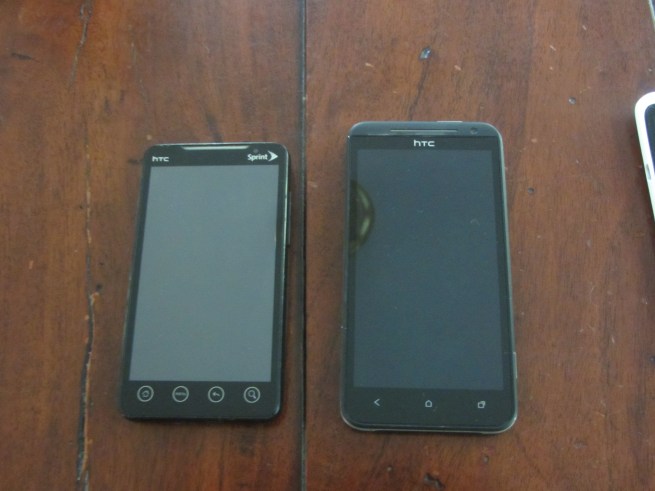
Original EVO 4G, left, new, less 4G EVO ONE, right
When the original HTC EVO launched on Sprint two years ago, it was a game-changer of a phone. It was the first Android device with a 4.3-inch display, 1GHz Processor, 4G WiMAX, and a host of other new technologies including something important that is often jokingly overlooked: a kickstand.
Consider this: Nokia’s current flagship Windows Phone 7 device carries the same 4.3-inch 800-by-480-pixel resolution and single core processor with 512MB of RAM. This is two years later, mind you. And, there are still lots of other phones that lag behind the original EVO. In fact, in one important way, today’s review-ee, the HTC EVO One, also lacks the original EVO’s ability to do 4G data. (Oh, and what perfect two-year contract renewal timing otherwise!)
Sprint finds itself in the middle of a debilitating transition from WiMAX to LTE on its mobile network. I will not go into the details, because it is water under the bridge, but the long story short is that Sprint is migrating to LTE from its previous 4G technology called “WiMAX.” Sprint has a host of phones running WiMAX now and needs to keep the lights on those devices until 2015 (including offloading some bandwidth to its pre-paid customers). At the same time, it has to eek out some spectrum for a new type of 4G service and still keep those 3Gers happy.

The One Family: Evo One(Sprint), One X (AT&T) and One S (T-Mobile)
Unfortunately, Sprint is only now ramping up its LTE offering as AT&T and Verizon already have many major cities covered. When the EVO One is released today (after a longer than expected layover in customs thanks to Apple), it will not be able to use LTE 4G anywhere. Worse yet, it does not have WiMAX radios, so it is basically on the same level as the iPhone for Sprint customers network-wise.
The original EVO launched at the same time that Sprint’s 4G was rolling out, so you might be saying, “Big deal? The EVO had to wait for 4G and was a success.”
Things have changed immensely over the last two years. If you are buying a superphone in the U.S. now, you expect a super network. The EVO ONE will have to wait a long time to even access a two-year-old-type of 4G speed. Sprint is rolling out its LTE in Dallas, Atlanta, Houston, and San Antonio with some mystery markets, but it should have only 10 markets covered by July. That means only a small percentage of the U.S. is going to be able to really use this phone.
(As an aside, this is Sprint not learning from its WiMAX rollout. Sprint was ahead in its 4G tech by a year, but it chose to roll it out in markets like Baltimore and Portland. By the time it got around to major tech/news hubs like New York and San Francisco, Verizon had already announced LTE rollouts and swallowed Sprint’s tech lead.)
If I am a Sprint user (and I am), there is no way I am going to trade a WiMAX smartphone for a non-working LTE one until more of the network is rolled out. WiMAX works great in New York and San Francisco. In fact, I still use my original EVO as a hotspot, because the network is often better than the other carriers’ 4G in the area. There are no current plans for Sprint LTE in my area (New York City).
If HTC/Sprint could have built a phone with dual WiMAX/LTE radios, I would be all over this phone in a heartbeat. However, as it stands, and until Sprint’s LTE gets more mature, it is hard to recommend.
How is the phone itself?
The EVO One is very similar to AT&T’s ONE X—same screen and guts. Truth be told, I like the feel of the One X better than the three-tone (FUGLY matte plastic, red stripe/shiny plastic) back of the EVO One. However, the kickstand more than makes up for the appearance. The EVO One also features a camera shutter button that many people will find super handy.
From here, you can pretty much head over to the HTC ONE X review.
Android 4.0 flies, the 4.7-inch 720P screen is amazing, the 2000mAh battery lasts all day (on 3G anyway), and then some. Sprint’s apps are annoying, but you can disable them. I was not able to check the HD call quality, because there was not any LTE or anyone else with the same features, but it looks to be a nice aspect when released.
I am not sure if it’s their market position as underdogs, but both T-Mobile and Sprint seem to treat their customers better than AT&T and Verizon. While T-Mobile offers perks like Wi-Fi calling, Sprint does not block Google Wallet and integrates Google Voice, which are both fantastic services. Sprint cautioned that Google Wallet is still in Beta on the phone, so I did not use it much. I think this will be big for Google platform people going forward.
Wrap up:
The HTC EVO ONE is an amazing phone overall. If your market is on Sprint’s secret LTE rollout plan, and you will not often find yourself leaving the area, by all means jump on this phone. If you are in a situation like me, where WiMAX is up and running, and LTE is who knows how far off, then I would recommend holding off or keeping your old EVO. Alternatively, if you can handle the terms, you can also jump carriers. Sprint should have a hybrid WiMAX LTE device, or it should bundle these phones with a WiMAX hotspot, if they expect those who bought the original EVO two years ago to upgrade.
Here is an idea: Let your customers keep their faster original EVO 4G to use as a hotspot!

FTC: We use income earning auto affiliate links. More.



Comments